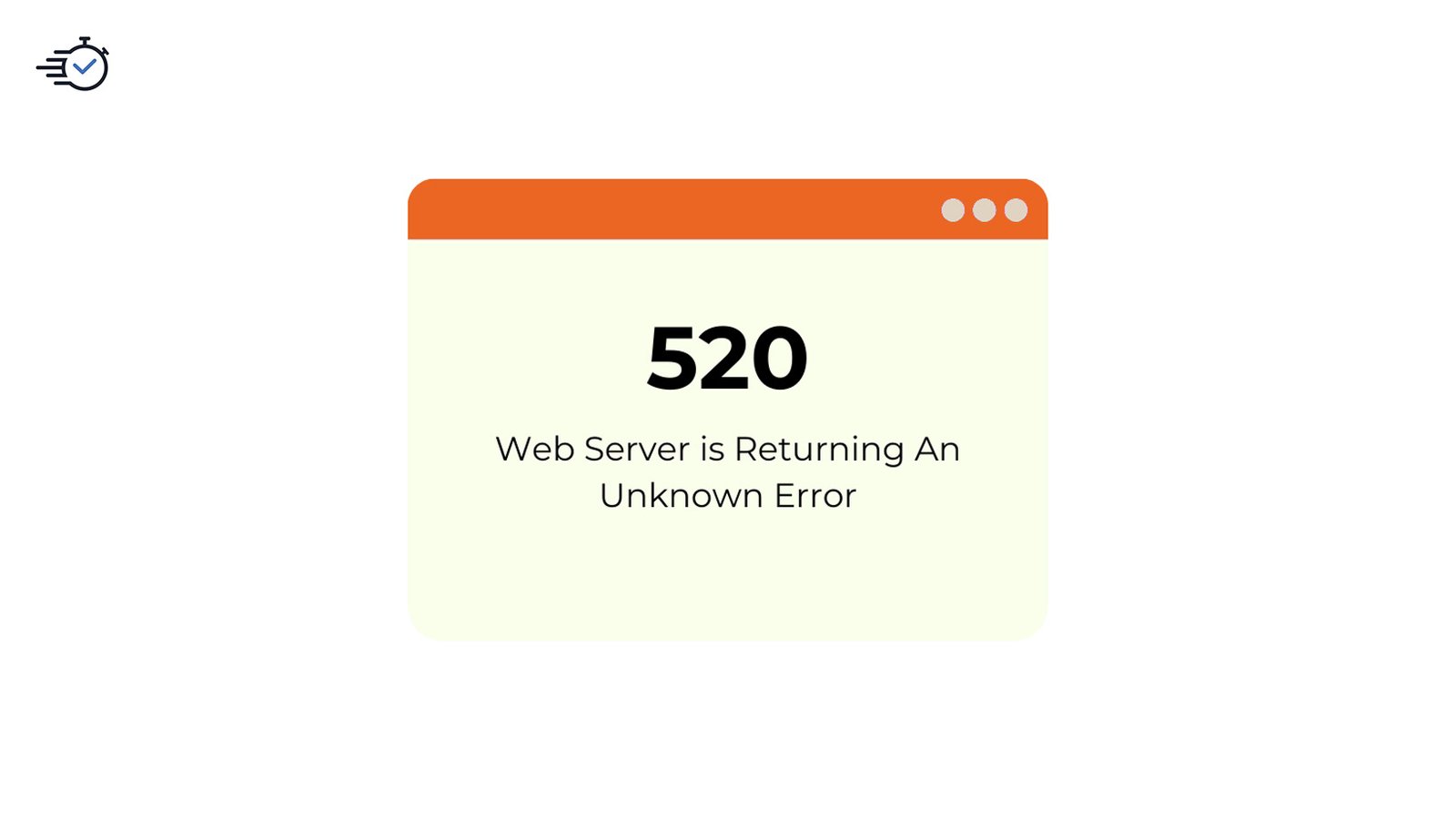Error Code 520, commonly known as the “Web Server Returning an Unknown Error,” is a server-facet trouble encountered by websites utilizing Cloudflare’s services as a CDN (Content Delivery Network) and opposite proxy. It indicates a breakdown in communication between Cloudflare’s side servers and the starting server hosting the website. The blunders occur when the starting server sends an invalid, empty, or unexpected reaction, which Cloudflare can not system, causing brief website inaccessibility for customers.
In this complete guide, we’ll explore every detail about Ode 520, including why it occurs, the results on your website, and how to resolve it step by step. We’ll also discuss long-term strategies to ensure your websites function seamlessly.
What Is Error Code 520?
Error Code 520 is an HTTP popularity code particular to Cloudflare’s platform. This mistake shows that the website’s foundation server failed to reply efficiently to Cloudflare’s request. In assessing additional HTTP mistakes like 404 (Not Found) or 500 (Internal Server Error), Error 520 is specific to websites raging Cloudflare’s capabilities, including visitor routing, protection, and content caching.
When a visitor attempts to access a Cloudflare-enabled website, the request first passes through Cloudflare’s part servers. Suppose those servers cannot retrieve a valid response from the foundation server because of unexpected errors. In that case, they return Error 520 to the user.
How Does Error 520 Differ from Other HTTP Errors?
While similar to HTTP 502 (Bad Gateway) or 504 (Gateway Timeout), Error 520 is specific as it occurs handiest in Cloudflare’s atmosphere. It signals inner trouble among Cloudflare and the starting place server instead of directly concerning the user’s browser or internet connection.
Key Characteristics of Error Code 520
- Sudden and Unpredictable
Error 520 typically appears without caution, making it challenging for website administrators to expect or prevent it without proactive server monitoring.
- Exclusive to Cloudflare
This error is specific to websites using Cloudflare’s services. Non-Cloudflare websites will no longer experience Error 520.
- Unique Ray ID for Troubleshooting
Each prevalence of Error 520 is associated with a particular Ray ID, a diagnostic identifier that Cloudflare provides on the mistake web page. This ID facilitates tracking the problem within server logs or escalating it to Cloudflare’s support group.
- Temporary or Persistent
The errors can arise intermittently, regularly during excessive visitor periods, or persistently if underlying server troubles remain unresolved.
Why Is Fixing Error 520 Important?
Unresolved Error 520 issues can notably affect your website and its users. The key influences include:
- Financial Loss
For e-trade or subscription-based total structures, downtime due to Error 520 can result in misplaced income, uncompleted transactions, or overlooked possibilities to engage with users.
- Reduced User Trust
Frequent server errors frustrate users, causing them to lose faith in your website’s reliability. For corporations, this could lead to the loss of returning site visitors or customers.
- Search engine marketing Penalties
Search engines, like Google, penalize websites with common downtime by decreasing their visibility in search outcomes. This impacts your natural site visitors and online presence.
What Causes Error Code 520?
- Misconfigured Origin Server
Server misconfigurations are the most common cause of Error 520. Examples encompass:
- Malformed HTTP Headers: If the beginning server sends headers that are outsized, improperly formatted, or exceed HTTP protocol limits, Cloudflare can not process them.
- Unsupported Status Codes: The server may additionally return unusual HTTP status codes that Cloudflare can’t interpret.
- Missing Server Components: Key configurations, database connections, and backend tactics may be absent due to incomplete responses.
- Firewall or Security Plugin Blocking Cloudflare
Firewalls or safety plugins established at the starting place server might also mistakenly block Cloudflare’s IP addresses, treating valid visitors as malicious. This interference prevents the right verbal exchange between Cloudflare and the server.
- Empty or Invalid Server Responses
Invalid server responses occur while the origin server sends incomplete or blank statistics. Common reasons encompass:
- Application Crashes: Errors in backend packages (e.g., PHP scripts) can halt server-facet processes.
- Server Resource Issues: Insufficient CPU, memory, or garage sources might also bring about incomplete responses.
- Improper Reboots: Sudden server restarts disrupt connections and save you legitimate responses.
- Server Overload
An overwhelmed server can’t cope with an excessive extent of simultaneous requests. This can show up at some stage in:
- Traffic surges (e.g., promotional occasions or DDOS attacks).
- Insufficient server capacity.
- SSL/TLS Handshake Failures
SSL/TLS certificate steady facts between Cloudflare and the foundation server. Errors, such as an expired certificate, unsupported encryption protocols, or misconfigured HTTPS settings, often lead to failed handshakes and Error 520.
- Network Connectivity Issues
Network-stage problems, such as high latency, packet loss, or routing issues between Cloudflare’s aspect servers and the origin server, might also cause connection screw-ups.
- Programming Bugs
Coding errors in backend scripts, specifically in languages like PHP, can cause invalid responses. Examples encompass:
- Fatal Errors: Unhandled exceptions or missing dependencies.
- Infinite Loops: Poorly written loops can exhaust server resources.

How to Fix Error Code 520
Resolving Error 520 requires systematic troubleshooting. Follow these steps:
1. Verify Cloudflare DNS Settings
Start by making sure that Cloudflare’s DNS settings correctly point to your foundation server.
- Check that the A, AAAA, and CNAME records in Cloudflare’s dashboard suit your server’s IP.
- Avoid replica or conflicting entries.
- Test the connection by briefly toggling the proxy frame to “DNS Only.”
2. Analyze Server Logs
Server logs can provide distinct insights into potential issues.
- For Apache: Review /var/log/apache2/error.Log.
- For Nginx: Review /var/log/nginx/error.Log.
Compare timestamps from the logs with the Ray ID displayed inside the mistakes message to isolate the hassle.
3. Temporarily Disable Firewalls or Security Plugins
If a firewall or safety device is misidentifying Cloudflare site visitors, try these steps:
- Temporarily disable firewalls or plugins to look if the error resolves.
- Whitelist Cloudflare’s IP tiers for your server settings. You can locate the up to date list here.
4: Restart Server Components
Sometimes, restarting the server or backend processes resolves transient issues. Use commands like:
bash
sudo systemctl restart apache2
sudo systemctl restart php7.4-fpm
sudo systemctl restart nginx
5: Increase Timeout Values
Adjust timeout settings to prevent idle connections from being prematurely terminated.
- For Nginx: Add keepalive_timeout 65; in nginx.conf.
- For Apache: Set Timeout 300 in httpd.conf.
6. Optimize Resource Allocation
Ensure your server can manage visitors demands:
- Use load balancing to distribute traffic throughout multiple servers.
- Upgrade to a website hosting plan with higher overall performance competencies.
- Implement caching mechanisms for static assets.
7. Check and Update SSL/TLS Certificates
Ensure that your SSL/TLS certificates are valid and properly configured. Test for SSL problems using gear like SSL Labs or OpenSSL commands.
8. Contact Cloudflare Support
If none of the above steps resolve the issue, boost to Cloudflare Support with the following details:
- The Ray ID is displayed inside the blunder message.
- A replica of your server logs.
- A listing of troubleshooting steps already taken.
Preventative Measures for Error Code 520
- Regular Maintenance: Keep your server and website software up to date to avoid configuration issues.
- Monitoring Tools: Use offerings like Pingdom, New Relic, or Uptime Robot to come across and cope with troubles proactively.
- Security Optimization: Configure firewalls and allowlist trusted IP levels like Cloudflare’s.
- Efficient Code Practices: Review backend code for mistakes, inefficiencies, or endless loops.
- Server Resource Scaling: Upgrade server sources as site visitor demands develop.
FAQs About Error Code 520
Q1. Can Error 520 be avoided completely?
While a few causes (like transient outages) may be unavoidable, proactive server renovation, the right configurations, and monitoring tools can significantly lessen the probability of encountering Error 520.
Q2. Does Error 520 affect all websites?
No, Error 520 is distinct to websites using Cloudflare’s offerings. Websites without Cloudflare will no longer experience this error.
Q3. What is the Cloudflare Ray ID, and why is it critical?
The Ray ID is a unique identifier Cloudflare assigns to each error instance. It allows directors to trace and diagnose the unique reason for the difficulty.
Conclusion
Error Code 520 can disrupt your website’s operations, impacting users and search engine rankings. However, with systematic troubleshooting, proper server control, and proactive tracking, you can effectively deal with and prevent this problem.
Following this comprehensive guide, internet site owners can ensure minimal downtime, guard their reputation, and hold an unbroken person revel in.
Also Checkout: Xbox 360 Error Code 8015d086: Causes, Fixes & Proactive Tips





